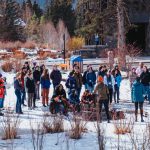Below the surface of Lemon Creek: Elevating our understanding of high elevation freshwater systems
As we trade our warm jackets and boots for t-shirts and sandals, the world outside our front door is changing too. The annual spring freshet transforms our streams and rivers. Flowing high in the Selkirk Mountains of southeastern British Columbia, one creek is currently recharging with the snow and ice melt – a critical step to support its 13 water licences.
Located in Kokanee Glacier Provincial Park, Lemon Creek flows from Upper Sapphire Lake at 2,263 metres above sea level into the Slocan River. As a fish-bearing tributary, Lemon Creek’s waters sustain a diversity of fish species including Bull Trout, Rainbow Trout and Mountain Whitefish. The creek is also subject to numerous water licences, supporting municipal and agricultural water needs in the area.
It’s safe to say that Lemon Creek is heavily relied upon by both humans and wildlife. But, research¹ suggests that small changes in climate can drive large shifts in alpine freshwater systems, such as Lemon Creek. Shorter winters, earlier spring melt, and increased rainfall will continue to have an impact on the health and function of alpine ecosystems.
This is where the High Elevation Monitoring Program comes into the picture. Through gathering comprehensive data on alpine ecosystems, Living Lakes Canada’s High Elevation Monitoring Program aims to better understand climate change impacts on these sensitive spaces, many of which have never been monitored before. The insight gained through monitoring will help inform sustainable water management and support climate change adaptation for future generations.

In 2022, our High Elevation Monitoring Program began surveying in the alpine of the West Kootenays. Lemon Creek has long been known as an important water source. The Slocan River Streamkeepers have been monitoring this creek with temperature loggers for a number of years. Last fall, Living Lakes Canada in partnership with Slocan River Streamkeepers conducted a CABIN monitoring of Lemon Creek. To continue learning about this freshwater system, Lemon Creek was selected to be part of this new high elevation study area, along with Huss Creek and four alpine lakes. Monitoring field trips to date have included measuring the water’s biological, physical and chemical characteristics, and capturing photographs to track changes on a landscape level.

The High Elevation Monitoring Program also tracks climate, streamflow, snowpack, and glacier mass balance. Climate variability and streamflow parameters are collected through climate and hydrometric stations installed as part of the Columbia Basin Water Monitoring Framework and in combination with existing climate stations. Snowpack measurements are shared by partnering backcountry lodge owners, and glacier mass balance is collected and published by the World Glacier Monitoring Service.
With longer, hotter dry periods on the horizon, monitoring high elevation headwaters is top of mind. The BC Government River Forecast Centre noted in their February 1st Snow Survey and Water Supply Bulletin that the B.C. snow pack is 21% below normal and there are “early concerns for drought extending into the spring and summer with below normal snow throughout many regions.”
Drought and water scarcity are climate impacts that will increasingly be felt by human and biological communities across Canada. Monitoring Lemon Creek is a start, but with your support, we can continue to expand the High Elevation Monitoring Program throughout the Canadian Columbia Basin, and refine this high elevation program so it can be used as a model in other areas.
Will you help us gain a comprehensive and science-based understanding of our alpine headwaters?






